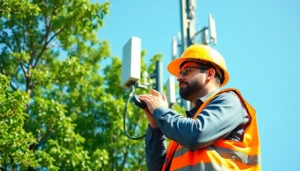
”
When I think about the evolution of telecommunications it’s fascinating to see how far we’ve come from the early days of copper wire networks and analog signals. Legacy telecommunications systems built the foundation for today’s digital communication landscape and continue to play a crucial role in many organizations.
I’ve spent years working with both traditional and modern telecom systems and I can tell you that understanding legacy infrastructure is essential for anyone in the communications field. While newer technologies like VoIP and fiber optics dominate headlines many businesses still rely on legacy systems for their core operations. These tried-and-true networks offer reliability and familiarity that some modern alternatives can’t match.
Key Takeaways
- Legacy telecommunications evolved from basic analog networks in 1876 to today’s integrated digital systems, with PSTN forming the foundation for modern communications
- Traditional landline systems rely on copper wire networks and circuit-switching technology, supporting bandwidth of 3-4 kHz and distances up to 18,000 feet with reliable voice transmission
- Key legacy technologies like PSTN and ISDN continue supporting critical business operations, with ISDN offering data rates up to 1.544 Mbps (T1) or 2.048 Mbps (E1)
- Maintaining legacy systems presents significant challenges, including high maintenance costs ($5,000-$15,000 annually per PBX) and difficulty sourcing replacement parts with 300-500% markup
- Major carriers plan to phase out legacy infrastructure by 2025-2030, affecting millions of connections, with AT&T targeting 12.5 million copper line subscribers for migration to modern networks
- Rural communities face unique challenges during the transition, with 15% still relying on copper-based services and higher fiber installation costs ($5,800/mile vs $2,200/mile in urban areas)
Legacy Telecommunications
Legacy telecommunications underwent five distinct transformation phases from 1876 to the present day:
Early Analog Networks (1876-1960)
Alexander Graham Bell’s telephone network established the foundation of telecommunications in 1876. The Public Switched Telephone Network (PSTN) emerged as the primary infrastructure, connecting homes through copper wires transmitting analog voice signals. Manual switchboards handled call routing with operators physically connecting circuits.
Digital Revolution (1960-1990)
Digital switching systems replaced analog exchanges in the 1960s. The introduction of:
- Time Division Multiplexing (TDM)
- Pulse Code Modulation (PCM)
- Electronic switching systems
- Touch-tone dialing
Network Modernization (1990-2000)
Telecommunications infrastructure expanded with:
- Fiber optic backbones
- Digital subscriber lines (DSL)
- ISDN implementation
- Enhanced call routing
- Automated switching systems
| Technology | Speed Improvement | Implementation Year |
|---|---|---|
| Basic PSTN | 64 Kbps | 1876 |
| ISDN | 128 Kbps | 1988 |
| DSL | 1.5 Mbps | 1991 |
| T1 Lines | 1.544 Mbps | 1962 |
Integration Period (2000-2010)
Legacy systems integrated with emerging technologies:
- VoIP compatibility layers
- IP-based switching
- Hybrid PBX systems
- SIP trunking services
- Digital-analog converters
- Cloud-based integration
- Virtual PBX solutions
- Software-defined networking
- API connectivity
- Unified communications platforms
Early Telephone Networks and Infrastructure
Early telephone networks required extensive physical infrastructure, consisting of copper wires connecting individual telephones through centralized switching stations.
Manual Switchboards and Operators
Manual switchboards formed the backbone of telephone communication from 1876 to 1940. The first commercial telephone exchange opened in New Haven, Connecticut, in 1878 with 21 subscribers. Operators connected calls by physically inserting copper plugs into jacks on a switchboard matrix, handling 50-100 calls per hour. The system employed predominately female operators, known as “”Hello Girls,”” who managed multiple connection requests simultaneously through:
- Direct voice communication with callers
- Physical cord manipulation on the switchboard
- Management of multiple concurrent connections
- Maintenance of call duration records
- Step-by-step switches that eliminated manual operator intervention
- Rotary dial mechanisms for direct number input
- Mechanical selectors that processed up to 10,000 lines
- Cross-bar switching systems increasing capacity to 100,000 lines
| Year | Technology Milestone | Impact |
|---|---|---|
| 1878 | First commercial exchange | 21 subscribers |
| 1892 | Strowger switch invented | Automated calling |
| 1919 | Rotary dial standardized | User-controlled dialing |
| 1938 | Crossbar switching | 10x capacity increase |
Traditional Landline Systems
Traditional landline systems form the backbone of legacy telecommunications infrastructure through copper-based networks and circuit-switched technology. These systems established reliable voice communication channels that many organizations continue to use today.
Copper Wire Networks
Copper wire networks utilize twisted pair cables that transmit electrical signals across long distances. The physical infrastructure consists of:
- Local loops connecting individual premises to central offices
- Trunk lines carrying multiple signals between switching centers
- Distribution frames organizing connections at central offices
- Underground conduits protecting cables from environmental damage
- Terminal blocks providing connection points for individual lines
The copper network specifications include:
| Component | Specification |
|---|---|
| Wire Gauge | 22-26 AWG |
| Bandwidth | 3-4 kHz |
| Maximum Distance | 18,000 feet |
| Signal Loss | 0.5-2 dB/mile |
| Pair Count | 25-3600 pairs per cable |
Circuit Switching Technology
Circuit switching creates dedicated end-to-end connections for voice calls through:
- Physical paths reserved for entire call duration
- Time Division Multiplexing (TDM) enabling multiple calls per line
- Class 4/5 switches routing calls between exchanges
- Signaling System 7 (SS7) managing call setup protocols
- E&M signaling coordinating trunk line connections
| Switch Level | Function | Capacity |
|---|---|---|
| Class 5 | Local Exchange | Up to 10,000 lines |
| Class 4 | Toll Center | Up to 100,000 lines |
| Class 3 | Primary Center | Up to 200,000 lines |
| Class 2 | Sectional Center | Up to 500,000 lines |
| Class 1 | Regional Center | Over 500,000 lines |
Key Legacy Telecommunications Technologies
Legacy telecommunications technologies form the foundation of modern communication systems through their robust architecture and standardized protocols. These technologies continue to support critical business operations worldwide.
PSTN Architecture
The Public Switched Telephone Network (PSTN) architecture consists of hierarchical switching levels that process voice calls through circuit-switched networks. The architecture includes:
- Local Exchanges: Class 5 switches that connect directly to end-users
- Tandem Offices: Class 4 switches that route calls between local exchanges
- Regional Centers: Class 3 switches managing inter-city connections
- Sectional Centers: Class 2 switches handling state-level routing
- Primary Centers: Class 1 switches controlling national traffic
| Switch Class | Typical Capacity | Coverage Area |
|---|---|---|
| Class 5 | 10,000-100,000 lines | Local area |
| Class 4 | 100,000+ connections | City/Metro |
| Class 1-3 | 1M+ connections | Regional/National |
ISDN Systems
Integrated Services Digital Network (ISDN) technology enables simultaneous transmission of voice data through digital channels over traditional copper lines. ISDN offers:
- Basic Rate Interface (BRI):
- Two 64 Kbps B-channels for voice/data
- One 16 Kbps D-channel for signaling
- Total bandwidth of 144 Kbps
- Primary Rate Interface (PRI):
- 23 B-channels (T1) or 30 B-channels (E1)
- One 64 Kbps D-channel
- Total bandwidth of 1.544 Mbps (T1) or 2.048 Mbps (E1)
- Circuit-switched voice calls
- Packet-switched data transfers
- Video conferencing sessions
- Fax transmissions
Challenges of Maintaining Legacy Systems
Legacy telecommunications systems face critical maintenance hurdles due to aging infrastructure and evolving technology standards. These challenges impact operational efficiency while increasing maintenance costs for organizations relying on traditional telephony systems.
Cost and Resource Allocation
Maintaining legacy telecommunications infrastructure requires significant financial investment in specialized equipment maintenance tools. The annual maintenance costs for legacy PBX systems range from $5,000 to $15,000 per system, including:
- Labor expenses for trained technicians with expertise in obsolete technologies
- Regular hardware upgrades to maintain compatibility with modern networks
- Emergency repair services at premium rates during system failures
- Energy consumption costs from older less efficient equipment
- Software licensing fees for outdated management systems
- Limited availability of critical components like circuit cards line interface modules
- Increased pricing due to scarcity (300-500% markup on discontinued parts)
- Reliability concerns with third-party replacement components
- Extended lead times averaging 4-6 weeks for specialized parts
- Compatibility issues between original refurbished components
| Component Type | Average Lead Time | Markup % |
|---|---|---|
| Circuit Cards | 4-6 weeks | 300% |
| Power Supplies | 2-3 weeks | 200% |
| Line Modules | 5-8 weeks | 500% |
| Interface Cards | 3-4 weeks | 400% |
Modern Integration and Migration
Legacy telecommunications systems integrate with modern digital networks through specialized interfaces and protocols that maintain service continuity. These integration points enable organizations to modernize their infrastructure while preserving essential legacy functions.
Hybrid Network Solutions
Hybrid networks combine legacy telecommunications infrastructure with modern IP-based systems through specialized gateways and protocols. The integration components include:
- Media gateways that convert TDM voice signals to IP packets
- Session Border Controllers (SBCs) managing protocol transitions between networks
- SS7-to-SIP conversion interfaces connecting PSTN to VoIP systems
- Dual-stack PBX systems supporting both analog lines and IP endpoints
| Integration Component | Primary Function | Typical Capacity |
|---|---|---|
| Media Gateway | Signal Conversion | 2,000 concurrent calls |
| SBC | Protocol Management | 10,000 sessions |
| SS7 Gateway | Network Bridging | 5,000 signaling paths |
| Dual-stack PBX | Hybrid Switching | 1,000 extensions |
- Phased migration starting with non-critical systems
- Parallel operation of legacy and modern systems during transition
- Implementation of unified communications platforms
- Migration of analog services to digital alternatives
- Deployment of cloud-based communication solutions
| Migration Phase | Duration | Success Metric |
|---|---|---|
| Assessment | 2-3 months | System inventory completion |
| Planning | 3-4 months | Migration roadmap approval |
| Implementation | 6-12 months | Service continuity maintenance |
| Testing | 2-3 months | Zero service disruptions |
The Future of Legacy Infrastructure
Legacy telecommunications infrastructure faces significant transformation as carriers plan systematic decommissioning of older systems. The shift toward modern networks brings both challenges and opportunities for different sectors of society.
Phase-Out Timeline
Major telecommunications providers have established concrete timelines for legacy system retirement. AT&T aims to complete PSTN decommissioning by 2025, affecting 12.5 million copper line subscribers. Verizon projects a 2030 deadline for full TDM network elimination, impacting 8.4 million legacy connections. These phase-outs follow a three-stage process:
- Cease new installations of legacy equipment in targeted areas
- Migrate existing customers to fiber or wireless alternatives
- Decommission outdated infrastructure components
| Provider | Target Year | Affected Connections |
|---|---|---|
| AT&T | 2025 | 12.5M |
| Verizon | 2030 | 8.4M |
| CenturyLink | 2027 | 6.2M |
Impact on Rural Communities
Rural areas experience distinct challenges during legacy infrastructure transitions. 15% of rural Americans rely exclusively on copper-based telephone services for communication. The replacement costs for legacy systems in rural areas average $5,800 per mile for fiber installation compared to urban costs of $2,200 per mile.
- Limited access to high-speed alternatives
- Higher deployment costs for new infrastructure
- Extended transition periods due to geographic isolation
- Emergency service reliability concerns
- Increased financial burden on local telecommunications cooperatives
| Rural Impact Factor | Statistical Measure |
|---|---|
| Population Dependent on Legacy Systems | 15% |
| Fiber Installation Cost (Rural) | $5,800/mile |
| Fiber Installation Cost (Urban) | $2,200/mile |
| Average Transition Period | 36 months |
Modern Communication Landscape
Legacy telecommunications systems have shaped our modern communication landscape in profound ways. While I’ve explored the journey from copper wires to digital networks the impact of these foundational technologies continues to influence today’s solutions.
The ongoing transition from legacy systems presents both challenges and opportunities. I believe understanding these systems is crucial as we navigate toward fully digital networks especially considering the 2025-2030 decommissioning timeline for major providers.
Looking ahead I see a hybrid future where legacy infrastructure gradually integrates with modern solutions. This evolution will require careful planning strategic investment and consideration for communities that still rely heavily on traditional systems.
“








